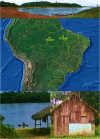Genetic Susceptibility to Neurodegeneration in Amazon: Apolipoprotein E Genotyping in Vulnerable Populations Exposed to Mercury
- PMID: 30100920
- PMCID: PMC6073741
- DOI: 10.3389/fgene.2018.00285
Genetic Susceptibility to Neurodegeneration in Amazon: Apolipoprotein E Genotyping in Vulnerable Populations Exposed to Mercury
Abstract
Human exposure to mercury is a serious problem of public health in Amazon. As in other vulnerable populations throughout the world, Amazonian riverine populations are chronically exposed to this metal and some symptoms of mercury intoxication were already detected in these populations. However, studies on the genetic susceptibility to mercury toxicity in the Amazon are scarce, and they tested a limited number of individuals. In this context, apolipoprotein E gene (APOE) is a key element with a well-established association among their alleles and the neurodegenerative consequences of mercury intoxication. However, no studies have addressed APOE genotyping in Amazonian exposed populations. Additionally, epidemiological studies with APOE genotyping in Amazon have been restricted to indigenous populations. Therefore, this work analyzed for the first time the genotypic and allelic profiles of APOE in Amazonian riverine populations chronically exposed to mercury. Eight hundred and twenty three individuals were enrolled in our study donating blood (794) and/or hair (757). APOE genotyping was analyzed by real-time PCR. Total mercury and mercury species were quantified by ICP-MS and GC-pyro-AFS, respectively. Genomic ancestry markers were evaluated by multiplex-PCR reaction, separated by capillary electrophoresis on the ABI 3130 Genetic Analyzer instrument and analyzed on GeneMapper ID v3.2. The 𝜀3 and 𝜀3/𝜀3 were the most frequent allele and genotype, respectively, followed by 𝜀4 allele and 𝜀3/𝜀4 genotype. Only 𝜀2/𝜀2 genotype was not found, suggesting that the absence of this genotype is a generalized phenomenon in Amazon. Also, our data supported an association between the presence of APOE4 and the Amerindian origin in these populations. Fifty-nine individuals were identified at maximum risk with levels of mercury above 10 μg/g and the presence of APOE4. Interestingly, among individuals with high mercury content, APOE4-carriers had high mercury levels than APOE2-carriers, pointing to a different heavy metal accumulation according to the APOE allele. These data suggest that APOE4, in addition to a possible pharmacodynamic effect, may influence pharmacokinetically the mercury exposure causing its higher accumulation and leading to worse deleterious consequences. Our results may aid in the development of prevention strategies and health policy decision-making regarding these at-risk vulnerable populations.
Keywords: ApoE; Tapajós; Tucuruí; allele; ancestry; genotype; human; methylmercury.
Figures



Similar articles
-
Environmental pollution challenges public health surveillance: the case of mercury exposure and intoxication in Brazil.Lancet Reg Health Am. 2024 Aug 30;39:100880. doi: 10.1016/j.lana.2024.100880. eCollection 2024 Nov. Lancet Reg Health Am. 2024. PMID: 39290578 Free PMC article. Review.
-
Hair mercury is associated with dyslipidemia and cardiovascular risk: An anthropometric, biochemical and genetic cross-sectional study of Amazonian vulnerable populations.Environ Res. 2023 Jul 15;229:115971. doi: 10.1016/j.envres.2023.115971. Epub 2023 Apr 25. Environ Res. 2023. PMID: 37105291
-
Assessing mercury intoxication in isolated/remote populations: Increased S100B mRNA in blood in exposed riverine inhabitants of the Amazon.Neurotoxicology. 2018 Sep;68:151-158. doi: 10.1016/j.neuro.2018.07.018. Epub 2018 Aug 1. Neurotoxicology. 2018. PMID: 30076900
-
In the Heart of the Amazon: Noncommunicable Diseases and Apolipoprotein E4 Genotype in the Riverine Population.Int J Environ Res Public Health. 2018 Sep 7;15(9):1957. doi: 10.3390/ijerph15091957. Int J Environ Res Public Health. 2018. PMID: 30205523 Free PMC article.
-
Role for apolipoprotein E in neurodegeneration and mercury intoxication.Front Biosci (Elite Ed). 2018 Jan 1;10(2):229-241. doi: 10.2741/e819. Front Biosci (Elite Ed). 2018. PMID: 28930615 Review.
Cited by
-
Raising awareness of riverine populations in the Brazilian Amazon about MeHg intoxication in APOE4 carriers: cardiovascular risk and potential benefit of native selenium diets.Front Toxicol. 2025 May 8;7:1571658. doi: 10.3389/ftox.2025.1571658. eCollection 2025. Front Toxicol. 2025. PMID: 40406630 Free PMC article. No abstract available.
-
Deciphering the Global Proteomic Profile Involved in Methylmercury-Induced Cerebellar Neurodegeneration and Motor Dysfunction in Adult Rats.Toxics. 2022 Sep 9;10(9):531. doi: 10.3390/toxics10090531. Toxics. 2022. PMID: 36136496 Free PMC article.
-
Environmental pollution challenges public health surveillance: the case of mercury exposure and intoxication in Brazil.Lancet Reg Health Am. 2024 Aug 30;39:100880. doi: 10.1016/j.lana.2024.100880. eCollection 2024 Nov. Lancet Reg Health Am. 2024. PMID: 39290578 Free PMC article. Review.
-
Maternal methylmercury exposure during early-life periods adversely affects mature enamel structure of offspring rats at human exposure levels: a concern for oral health.Front Public Health. 2023 Jun 30;11:1183308. doi: 10.3389/fpubh.2023.1183308. eCollection 2023. Front Public Health. 2023. PMID: 37457266 Free PMC article.
-
Methylmercury-Induced Toxicopathologic Findings in Salivary Glands of Offspring Rats After Gestational and Lactational Exposure.Biol Trace Elem Res. 2021 Aug;199(8):2983-2991. doi: 10.1007/s12011-020-02409-z. Epub 2020 Oct 3. Biol Trace Elem Res. 2021. PMID: 33009984
References
-
- Arrifano G. P. F., de Oliveira M. A., Souza-Monteiro J. R., Paraense R. O., Ribeiro-Dos-Santos A., Vieira J., et al. (2018a). Role for apolipoprotein E in neurodegeneration and mercury intoxication. Front. Biosci. 10 229–241. - PubMed
-
- Arrifano G. P. F., Martin-Doimeadios R. C. R., Jimenez-Moreno M., Ramirez-Mateos V., da Silva N. F. S., Souza-Monteiro J. R., et al. (2018b). Large-scale projects in the amazon and human exposure to mercury: the case-study of the Tucurui dam. Ecotoxicol. Environ. Saf. 147 299–305. 10.1016/j.ecoenv.2017.08.048 - DOI - PubMed
-
- Atlas of Human Development in Brazil (2013). The Atlas. São Luís: Atlas of Human Development.
LinkOut - more resources
Full Text Sources
Other Literature Sources
Research Materials
Miscellaneous

